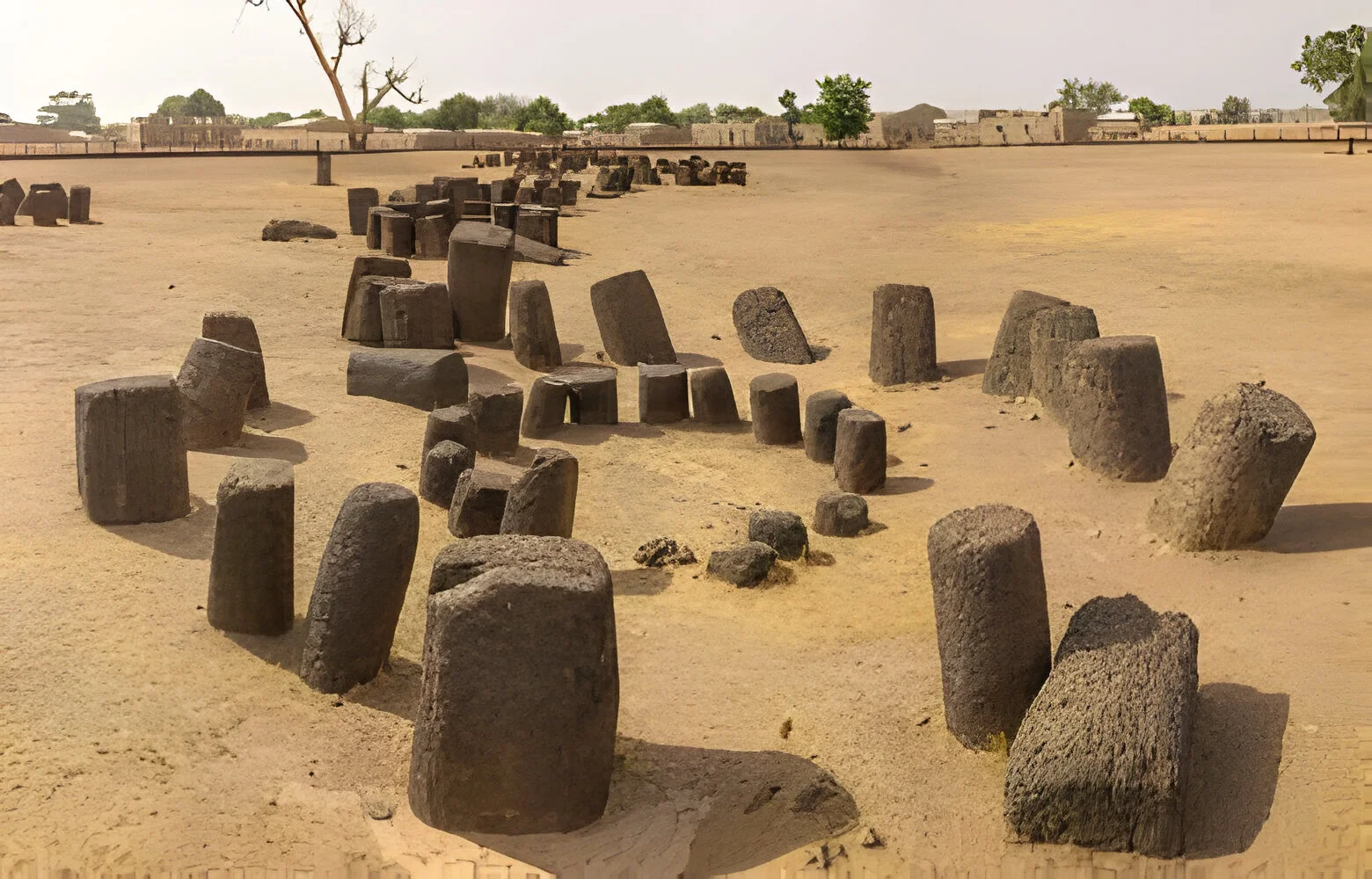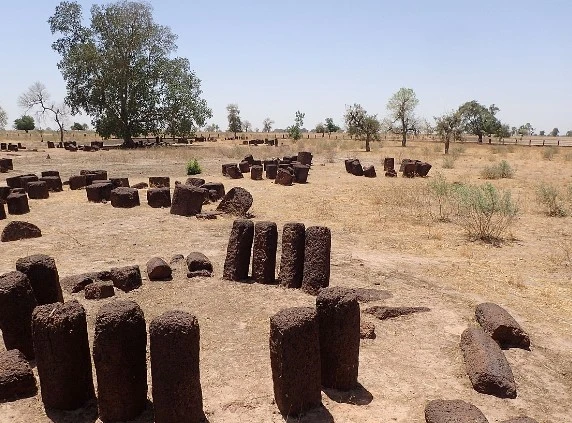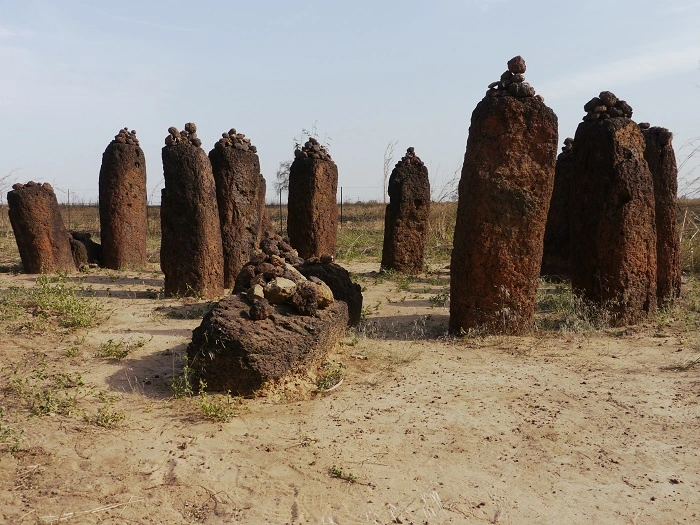The Senegambian Stone Circles
- Ebrima Sidibeh

- Mar 16, 2024
- 9 min read
So what are the Senegambian Stone Circles, and why should we care?
Well, these stone circles are a collection of more than 1,000 stone circles in the Gambia and Senegal. These circles were made by standing stones arranged in circles or horseshoe shapes. They’re believed to have been built as burial grounds and hold emotional importance.

Table of Contents:
Geographical Distribution
Archaeological Excavations
Cultural Significance
Key Highlights
There are over 1,000 stone circles located across Gambia and Senegal.
It took over 1,500 years for a prosperous society to create these stunning structures.
This type of megalithic construction is unique to West Africa.
UNESCO named this site a world heritage site due to its outstanding universal value.
These stones offer us insight into ancient cultures' customs, spiritual beliefs and symbolic meanings.
This historic wonder must be preserved at all costs so future generations can enjoy it too!
Introduction
A look at the past through the lens of The Senegambian Stone Circles proves just how rich West Africa’s history truly is. These beautiful structures stand in Gambia and Senegal today but were built by people thousands of years ago. And their purpose? To show off the craftsmanship ability that would be remembered forever.
More than 1,500 years ago a highly organized society decided to work on this project. And we know they had a lot of fun because they spent all that time creating more than an astounding one thousand monuments spanning along River Gambia! It’s important to note that these weren’t just regular ‘ol rocks either. The precision used during this build really demonstrates their skills.
It’s shocking how tough these things are too! They’ve managed to stay together throughout all those centuries while giving us valuable details about their cultural practices, spiritual beliefs and symbolic meanings. Clearly highlighting their Outstanding Universal Value!
For Future Generations
Of course UNESCO had no choice but to make The Senegambian Stone Circles a World Heritage Site. It was either that or risk having a riot on their hands! This title should ensure these stones are preserved. So when we’re long gone, those kids will be able to enjoy this historical marvel too.
Unraveling the History of Senegambian Stone Circles
The history of the Senegambian Stone Circles dates back to ancient times when the tradition of constructing stone circles was prevalent in the region. These stone circles were part of a larger cultural landscape, reflecting the spiritual beliefs and social organization of the communities that built them.
The stone circles of Senegambia are spread over a vast area, covering a band 100 km wide and extending 350 km along the River Gambia. The four main groups of stone circles, Sine Ngayène, Wanar, Wassu, and Kerbatch, comprise 93 circles and numerous burial mounds, including the stone circles of laterite pillars. These pillars and the associated burial mounds present a vast sacred landscape created over more than 1,500 years, showcasing the outstanding universal value of the related tumuli.

The Senegambian Stone Circles, located in Gambia and Senegal along the River Gambia and River Senegal, spans a 100 km wide area. The band stretches over 350 km long. This has formed a unique cultural landscape in West Africa. Within this region, four main groups of stone circles have formed: Sine Ngayène, Wanar, Wassu, and Kerbatch. Each group has its own characteristics and architectural features.
Archaeological Excavations
In order to date the monuments of the Senegambian Stone Circles and understand its significance, archaeological excavations were conducted on these sites. These diggings have unearthed artifacts and human burials including finds of burials which give evidence for not just dating the monuments but also understanding their importance in West African history.

Cultural Significance
These ancient stone circles are valuable pieces of history that were utilized by people who lived here thousands of years ago. They feature ceremonial sites that reflect the social structures, cultural practices, and spiritual beliefs of those who built them. Although we still do not know all there is to know about these stones - such as why they were built - many experts believe they served as burial sites or symbols of power within different social structures.
Red sandstone rocks are arranged in an almost perfect circular formation throughout these historic sites.... Stacked with some standing as high as 2 meters tall (6 feet), each rock weighs nearly 7 tons... And you’d never guess how the craftsmen carved them out… They used iron tools! It’s said that each stone was meticulously shaped symmetrically so they all almost looked identical to one another...
Here are some interesting facts you might be surprised by…
• Almost every stone stands at 2 meters (6 ft) tall
• Each rock weighs around 7 tons!
• They were made using iron tools.
• There are over 52 circles.
• Their purpose is still a mystery to this day.
• Some experts believe they served as burial sites.
• While others think that they symbolized power and social hierarchy.
The Senegambian Stone Circles are a vast sacred landscape stretching across much of Gambia and Senegal. Within the region, four main complexes — Sine Ngayène, Wanar, Wassu and Kerbatch — are characterized by their unique architecture and cultural importance. The Sine Ngayène complex in Senegal is the largest site within the Senegambian Stone Circles. It consists of 52 circles of standing stones including a double circle. The Wanar complex in Senegal also features 21 circles, some with lyre or bifed rocks with a cross piece between them. The Wassu complex in Guinea has 11 circles, and the Kerbatch complex in Gambia has nine circles including a double circle.The most recent excavations on these megalithic circles date to the Anglo-Gambian campaign led by Evans and Ozanne in 1964 and 1965.
Site Overview
Sine Ngayene (Senegal) is the largest and most significant site in Senegambian Stone Circles area showing traditional monumental megalithic construction © UNESCO

The geographical distribution of stone circles attests to extensive presence of megalithic structures throughout the Senegambia region, illustrating an Outstanding Universal Value as traditional monumental megalithic construction spread over a vast area along one of Africa’s major rivers with more than 1,000 stone circles scattered loosely across it.
Stone Circle sites: Significance
The cultural practices that fostered such advanced craftsmanship are reflected by these sites’ physical remains.
These four concentrations are among many found within this zone but represent the densest concentration.
Indeed they hold Outstanding Universal Value as “a traditional monumental megalithic construction spread over a vast area... more than 1,000 stone circles scattered along one of Africa’s major rivers” making them “a truly remarkable and unique UNESCO World Heritage Site”.
Cultural Importance For Local People
The Senegambian Stone Circles largely defines the cultural identity of the region and has deep spiritual significance for many. The sites are considered sacred by some communities, and they’re associated with spiritual beliefs, ancestral worship and cultural rituals.
Local people play a crucial role in their interpretation and preservation: They pass down knowledge about the sites from generation to generation, ensuring continuity in practices and protection of monuments.
Symbolism and Interpretations:
Dozens of stone circles have been found within the Senegambian Stone Circle area © UNESCO Images / Robin Peel

One interpretation of the stone circles is that they were used as burial sites. In this interpretation, the standing stones represented ancestral spirits and the circular formations symbolized life and death.
Another interpretation suggests that the stone circles were a way for people to show off their power. In this interpretation, larger circles meant bigger influence and higher social status.
The unique patterns in these circles have been associated with celestial symbolism, hinting at an ancient understanding of space.
All these interpretations highlight how complicated and deep all of it is. With more questions than answers, researchers have made it a mission to dig deeper and find out what everything means.
Recognition as a World Heritage Site
UNESCO has recognized these stone circles as having cultural importance worldwide. They acknowledge that there aren’t many places like them left in the world that offer insight into Senegambia’s past.
Because they are so important historically, socially, and culturally, UNESCO has ensured their protection for future generations. They want everyone to be aware of where they come from so that we can always remember our roots.
The Stone Circles in Folklore and Mythology
Stories about these stone circles have been passed down through generations by word of mouth alone.
Local Legends about the Circles
It makes sense that after hundreds of years, legends would pop up surrounding such beautiful structures. Stories about spirits protecting lands or magical treasures being hidden beneath the surface are commonly told around here.

People really believe these stories too. So much so that some cultures swear by them. These ancient monuments have become symbols for rich history and heritage in literature, music, visual arts — you name it!
In literature especially though these stones mean a lot! Traditional tales often retell ancient wisdom using them as tools to get points across more effectively.
In music we see similar themes. Songs inspired by ancient traditions are written all over Africa today thanks to them.
The enigmatic allure and architectural beauty of the stone circles have captured the imagination of artists, as evidenced by their inclusion in paintings, photographs, and sculptures.
Moreover, popular culture has also found inspiration in the Senegambian Stone Circles. Their presence in movies, books, songs, and video games is a testament to their enduring appeal and the universal fascination with ancient civilizations and their monuments.
Similarities and Differences
Stone circles are not unique to Senegambia. They can be found around the world. However, there are some features that set the Senegambian Stone Circles apart from other stone circles — some of which have been recognized as World Heritage Sites by UNESCO — you may be more familiar with:

Circular Shape: The Senegambian Stone Circles are almost perfectly circular. This symmetry is one of their most striking features.
Standing Stones: Like other stone circles around the world, each component circle consists of several standing stones placed upright into the ground.
Unique Features: What really makes them stand out is their unique features. For example, some of the stone circles in Senegambia contain cross pieces or “lyre” stones — bifid stones which have a cross piece strung between the two halves. These cross pieces (also known as frontal stones) are rare in other stone circles worldwide.
Another distinguishing feature is that while each standing stone in a component circle is unique due to natural wear and human modification over time (such as chipping), they are all nearly identical in shape and size. These resemble bottle gourds (or calabashes) that taper slightly at one end but are larger than any known such fruit or vegetable discovered elsewhere on Earth. These similarities showcase how highly skilled craftsmen built these structures.
Lessons and Insights
Each component circle was constructed by people who lived during different periods spanning tens of centuries. Together they provide valuable lessons about how many aspects of society changed over the course of time.

For example, the spatial associations of the component circles reveal a complex and organized society that planned and built these structures. The proximity to burial mounds suggest links to funeral practices and ancestor worship. Similarly, their consistent use over more than 1,000 years shows stability in both society and resources.
The skillful craftsmanship can also provide insights into ancient West African civilizations' construction techniques and technical knowledge.
Overall, the Senegambian Stone Circles offer a window into the past that reveals much about ancient West African civilizations’ social, cultural, and religious practices.
Conclusion
In short, they are an architectural marvel and a testament to the rich cultural heritage of Senegambia. Its World Heritage Site status also highlights its global relevance and significance.
While researchers have conducted scientific studies to unravel some of the mysteries surrounding these structures through archaeological excavations for several years now — theories about their purpose vary greatly — there is no denying their beauty. This beauty is made even more stunning when you consider that each stone was moved by human hands; hands which were almost certainly not equipped with advanced technology such as wheelbarrows or bulldozers.
With thousands still standing — albeit many damaged by human activity, weathering or natural erosion — locals legends still tell tales of how they were constructed. These legends don’t necessarily explain everything but do add intrigue to structure’s legacy nonetheless: Times when women gathered in droves during nighttime for mysterious rituals involving snakes; times when giants walked the earth and only slept once every eight days; times when death-defying feats were routine because humans weren't normal humans but had powers akin to those we see only in movies today.
Of course this may sound far-fetched now but back then it wasn't just common sense — it was reality.
Also referred to as "the Gambia," together with Sudan-based Mauritania it is one of two countries named after what flows through it: the Gambia River. It's also one of the most densely populated in Africa, with the capital city Banjul having a population density of 448 people per square kilometer (1,160 per square mile), according to the CIA World Factbook.
At its narrowest point it is just 20 miles wide; at its widest it expands to about 50 miles. The country is known for its large bird sanctuary that sits along its riverbanks and the beautiful beaches that stretch along its Atlantic coast on the westernmost part of Africa.
Frequently Asked Questions
What are the major theories about the purpose of the stone circles?
There are several major theories about what they were used for. Some say they served as burial sites, with each component circle representing a resting place and surrounding burial mounds and tumuli housing remains. Others say they had religious or spiritual significance, possibly connected to ancestor worship or other ritual practices. The exact purpose is still under investigation.









Comments